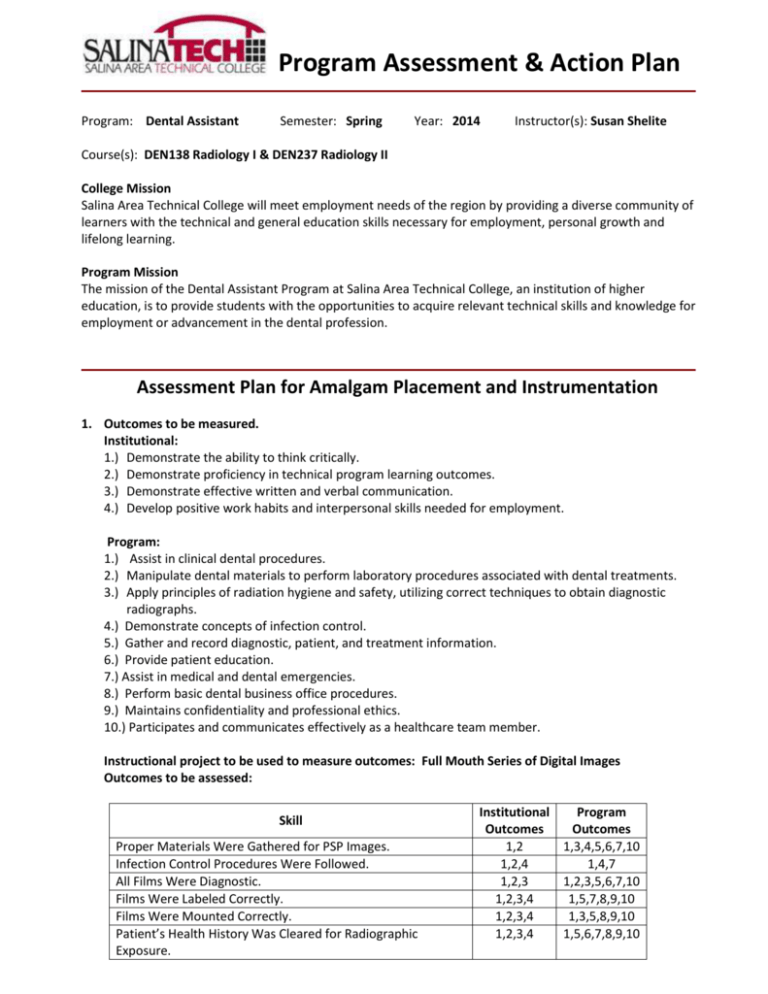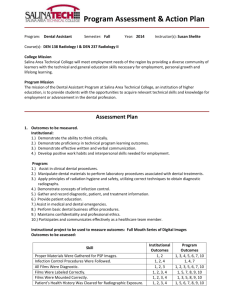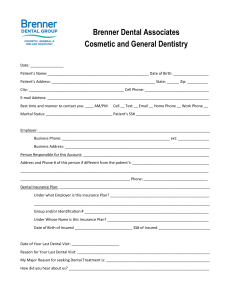Dental Assistant
advertisement

Program Assessment & Action Plan Program: Dental Assistant Semester: Spring Year: 2014 Instructor(s): Susan Shelite Course(s): DEN138 Radiology I & DEN237 Radiology II College Mission Salina Area Technical College will meet employment needs of the region by providing a diverse community of learners with the technical and general education skills necessary for employment, personal growth and lifelong learning. Program Mission The mission of the Dental Assistant Program at Salina Area Technical College, an institution of higher education, is to provide students with the opportunities to acquire relevant technical skills and knowledge for employment or advancement in the dental profession. Assessment Plan for Amalgam Placement and Instrumentation 1. Outcomes to be measured. Institutional: 1.) Demonstrate the ability to think critically. 2.) Demonstrate proficiency in technical program learning outcomes. 3.) Demonstrate effective written and verbal communication. 4.) Develop positive work habits and interpersonal skills needed for employment. Program: 1.) Assist in clinical dental procedures. 2.) Manipulate dental materials to perform laboratory procedures associated with dental treatments. 3.) Apply principles of radiation hygiene and safety, utilizing correct techniques to obtain diagnostic radiographs. 4.) Demonstrate concepts of infection control. 5.) Gather and record diagnostic, patient, and treatment information. 6.) Provide patient education. 7.) Assist in medical and dental emergencies. 8.) Perform basic dental business office procedures. 9.) Maintains confidentiality and professional ethics. 10.) Participates and communicates effectively as a healthcare team member. Instructional project to be used to measure outcomes: Full Mouth Series of Digital Images Outcomes to be assessed: Skill Proper Materials Were Gathered for PSP Images. Infection Control Procedures Were Followed. All Films Were Diagnostic. Films Were Labeled Correctly. Films Were Mounted Correctly. Patient’s Health History Was Cleared for Radiographic Exposure. Institutional Program Outcomes Outcomes 1,2 1,3,4,5,6,7,10 1,2,4 1,4,7 1,2,3 1,2,3,5,6,7,10 1,2,3,4 1,5,7,8,9,10 1,2,3,4 1,3,5,8,9,10 1,2,3,4 1,5,6,7,8,9,10 3. What process(es) will be used to collect data? A rubric will be used. 2. What are the intended results? 80% of the students will average a 3 or above on the rubric. 3. Who will analyze the data? Trish Hayden and Susan Sheltie Assessment Results 1. What were the results? a.) The goal was reached. All but one student attained an average of 3.0 on the rubric. b.) Students struggled with Program Outcome #2. The average on the rubric for this outcome was 2.43. Average Scores on Rubric - 14 Students 6 5 5 4 3 3 2 2 Number of Students 2 1 1 1 0 2.83 3.17 3.5 3.67 3.83 4 Rubric Score Rubric Scores 4 - Excellent 3 - Good 2 - Fair 1 - Poor 0 - No Effort Evident Average scores for each rubric category Proper Materials Gathered for PSP Images. Infection Control Procedures Were Followed. All Films Were Diagnostic. Films Were Labeled Correctly. Films were Mounted Correctly. Patient's Health History Was Cleared for Radiographic Exposure. 3.79 3.79 2.43 3.86 3.93 3.79 Institutional Outcomes 4 3.6 3.6 3.5 3.84 3.5 3 2.5 2 Rubric Scores 1.5 1 Demonstrate the ability to think critically Demonstrate Demonstrate Develop positive proficiency in effective written work habits and technical and verbal interpersonal program communication skills needed for learning employment outcomes Demonstrate the ability to think critically Demonstrate proficiency in technical program learning outcomes Demonstrate effective written and verbal communication Develop positive work habits and interpersonal skills needed for employment Rubric Scores 3.6 3.6 3.5 3.84 Program Outcomes 4 3.5 3 2.5 2 1.5 1 0.5 0 3.6 3.38 3.79 3.56 3.34 3.53 3.86 3.86 3.56 2.43 Assist in clinical procedures. Rubric Scores Rubric Scores 3.6 Manipulate dental materials to perform laboratory procedures associated with dental treatments. 2.43 Apply principles of radiation hygiene and safety, utilizing correct techniques to obtain diagnostic radiographs. Demonstrate concepts of infection control. Gather and record diagnostic, patient, and treatment information. Provide patient education. Assist in medical and dental emergencies. Perform basic dental business office procedures. Maintains confidentiality and professional ethics. Participates and communicates effectively as a healthcare team member. 3.38 3.79 3.56 3.34 3.53 3.86 3.86 3.56 2. What was learned through analyzing these results? a.) Program Outcome #2 directly correlates to only one skill on the rubric: All Films Were Diagnostic. 43% of the students received less than a 3 on this skill. Action Plan Based on Results and Analysis 1. Based on the analysis of the results, what steps will be taken to improve student learning? By implementing the following changes in instruction, increased percentages will be seen on the next student assessment: a.) More emphasis will be placed on the diagnostic radiographic image placement in conjunction with the PID of the dental radiology unit. b.) There will be increased human patient radiographic requirements. c.) Students will explain to the instructor in more detail what needs to be done differently with his/her radiograph technique to improve diagnostic radiographic quality. 2. What goals will be set as result of the above changes in instruction? Although the original goal of 80% of the students achieving an average of 3.0 or better was met and surpassed, the rubric will be used again next year because of the low score on the “Manipulate dental materials to perform laboratory procedures associated with dental treatments.” That Program Outcome is not acceptable. The goals for next year will be: a.) 80% of the students will average a 3.0 or above on the rubric. b.) 80% of the students will receive a 3.0 or above on the “All Films Are Diagnostic” skill. 3. What additional software, machinery, tools, etc… do you need that would help you teach this course(s) more effectively? a.) I feel to teach this course more effectively first and foremost, another manikin with human teeth/jaws would benefit the students greatly. The manikins we have now need to be sent in to the company for repairs. The ratchet mechanism is wearing out. b.) Another great investment would be 20 more phosphor plate sensors to allow students to utilize class time more effectively. This will allow more students to take digital phosphor plate images at one time. c.) Another piece of equipment that would support student learning would be another digital sensor. In order to increase students’ knowledge of dental software, a bridging software-Dexis would allow students learning digital sensor technology to learn another software, increasing his/her marketability to dentist offices. d.) If there was another computer in the radiology room, it would allow more students at one time to use digital sensor technology. e.) An upgrade of the DEN program’s intraoral camera is needed. Newer technology can be implemented using a USB intraoral camera to increase student learning for an initial dental exam and documentation skills.





